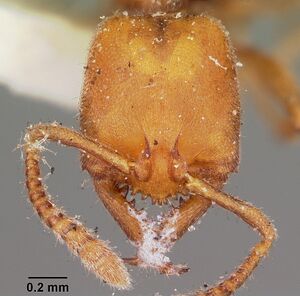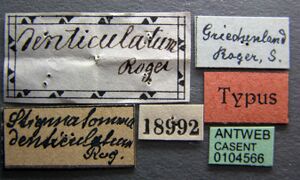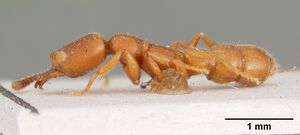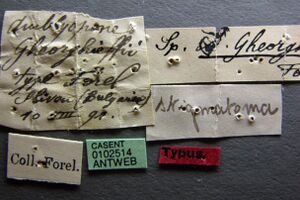Stigmatomma denticulatum
| Stigmatomma denticulatum | |
|---|---|

| |
| Scientific classification | |
| Kingdom: | Animalia |
| Phylum: | Arthropoda |
| Class: | Insecta |
| Order: | Hymenoptera |
| Family: | Formicidae |
| Subfamily: | Amblyoponinae |
| Tribe: | Amblyoponini |
| Genus: | Stigmatomma |
| Species: | S. denticulatum |
| Binomial name | |
| Stigmatomma denticulatum Roger, 1859 | |
| Synonyms | |
| |
This species is widely but sparsely distributed from Spain through southern Europe to the Balkans and the Middle East (Schembri & Collingwood, 1981).
Identification
Distribution
Latitudinal Distribution Pattern
Latitudinal Range: 45.399215° to 32.249974°.
| North Temperate |
North Subtropical |
Tropical | South Subtropical |
South Temperate |
- Source: AntMaps
Distribution based on Regional Taxon Lists
Oriental Region: Nepal.
Palaearctic Region: Albania, Bulgaria, Croatia, Greece (type locality), Israel, Italy, Lebanon, Malta, Morocco, North Macedonia, Romania, Serbia, Turkmenistan, Türkiye.
Distribution based on AntMaps
Distribution based on AntWeb specimens
Check data from AntWeb
Countries Occupied
| Number of countries occupied by this species based on AntWiki Regional Taxon Lists. In general, fewer countries occupied indicates a narrower range, while more countries indicates a more widespread species. |

|
Estimated Abundance
| Relative abundance based on number of AntMaps records per species (this species within the purple bar). Fewer records (to the left) indicates a less abundant/encountered species while more records (to the right) indicates more abundant/encountered species. |

|
Biology
Borowiec and Salata (2022) - Greece: Stigmatomma denticulatum is a thermophilous species most often collected close to streams in luminous deciduous and mixed forest. Sometimes the species was collected under stones in coniferous forest with mediterranean shrubs. In mountains, specimens were observed under limestones rocks and stones in pastures with oak shrubs. Nests were found under stones or in rock crevices on limestones walls exposed to sun. Collecting sites come from low and middle altitude (from 40 to 720 m).
Castes
Images from AntWeb
Worker
       
| |
| Worker. Specimen code casent0102470. Photographer April Nobile, uploaded by California Academy of Sciences. | Owned by MHNG, Geneva, Switzerland. |
   
| |
| Type of Stigmatomma denticulatum. Worker. Specimen code casent0104566. Photographer April Nobile, uploaded by California Academy of Sciences. | Owned by ZMHB, Berlin, Germany. |
    
| |
| Worker. Specimen code casent0102132. Photographer April Nobile, uploaded by California Academy of Sciences. | Owned by MSNG, Genoa, Italy. |
Queen
   
| |
| Queen (alate/dealate). Specimen code casent0102147. Photographer April Nobile, uploaded by California Academy of Sciences. | Owned by MSNG, Genoa, Italy. |
Male
   
| |
| Holotype of Amblyopone gheorghieffi. Male (alate). Specimen code casent0102514. Photographer April Nobile, uploaded by California Academy of Sciences. | Owned by MHNG, Geneva, Switzerland. |
Nomenclature
The following information is derived from Barry Bolton's Online Catalogue of the Ants of the World.
- denticulatum. Stigmatomma denticulatum Roger, 1859: 251, pl. 7, fig. 2 (w.) GREECE (Zakynthos I.).
- Type-material: holotype (?) worker.
- [Note: no indication of number of specimens is given.]
- Type-locality: Greece: Zante I. (= Zakynthos I.), Monte Scapo (v. Kiesenwetter).
- Type-depository: MNHU.
- Emery, 1875a: 74 (m.); Emery, 1909c: 357 (q.).
- Combination in Amblyopone: Emery & Forel, 1879: 455; Brown, 1960a: 168;
- combination in Stigmatomma: Dalla Torre, 1893: 14; Yoshimura & Fisher, 2012a: 19.
- Status as species: Mayr, 1861: 53 (in key); Roger, 1861a: 53; Roger, 1863b: 20; Mayr, 1863: 454; André, 1874: 187 (in key); Emery, 1875a: 74; Emery, 1875b: 471; Emery, 1878b: 50; Emery & Forel, 1879: 455; Emery, 1881b: 528; André, 1882c: 233 (in key); Forel, 1886e: clxvii; Saunders, E. 1890: 203; Dalla Torre, 1893: 14; Emery, 1895b: 59; Emery, 1909c: 357; Emery, 1911d: 24; Forel, 1913d: 427; Emery, 1914d: 156; Santschi, 1915a: 55 (in key); Emery, 1916b: 101 (in key); Bondroit, 1918: 80; Müller, 1921: 48; Finzi, 1923: 1; Müller, 1923b: 24; Finzi, 1924a: 15; Emery, 1924c: 164; Finzi, 1928b: 129; Finzi, 1930d: 311; Grandi, 1935: 98; Zimmermann, 1935: 7; Finzi, 1939b: 87; Consani & Zangheri, 1952: 39; Ceballos, 1956: 296; Brown, 1960a: 168, 197; Collingwood & Yarrow, 1969: 55; Baroni Urbani, 1971c: 9; Aktaç, 1977: 118; Collingwood, 1978: 74 (in key); Baroni Urbani, 1978a: 42 (redescription); Schembri & Collingwood, 1981: 420; Agosti & Collingwood, 1987a: 53; Agosti & Collingwood, 1987b: 264 (in key); Kugler, J. 1988: 256; Dlussky, Soyunov & Zabelin, 1990: 174; Tinaut, 1990d: 190; Atanassov & Dlussky, 1992: 61; Mei, 1992a: 412; Bolton, 1995b: 61; Poldi, et al. 1995: 2; Bračko, 2006: 134; Cagniant, 2006a: 195; Petrov, 2006: 83 (in key); Vonshak, et al. 2009: 38; Lapeva-Gjonova, et al. 2010: 4; Legakis, 2011: 3; Borowiec, L. & Salata, 2012: 536; Kiran & Karaman, 2012: 3; Borowiec, L. & Salata, 2013: 365; Borowiec, L. 2014: 161; Lebas, et al. 2016: 106; Borowiec, L. & Salata, 2018: 7; Salata & Borowiec, 2018c: 48.
- Senior synonym of gheorghieffii: Emery, 1915a: 255, Emery, 1916b: 100; Brown, 1960a: 168, 197; Baroni Urbani, 1978a: 42; Bolton, 1995b: 61.
- Senior synonym of gracilicornis: Brown, 1960a: 168, 197; Baroni Urbani, 1978a: 42; Bolton, 1995b: 61.
- Distribution: Albania, Bulgaria, Croatia, Gibraltar, Greece, Israel, Italy, Lebanon, Malta, Morocco, Romania, Serbia, Spain, Turkey.
- gheorghieffii. Amblyopone gheorghieffii Forel, 1892i: 309 (m.) BULGARIA.
- Type-material: holotype male.
- Type-locality: Bulgaria: Sliven, 10.viii.1891 (A. Forel).
- Type-depository: MHNG.
- Combination in Stigmatomma: Emery, in Dalla Torre, 1893: 14.
- Status as species: Dalla Torre, 1893: 14; Emery, 1909c: 358; Emery, 1911d: 24.
- Junior synonym of denticulatum: Emery, 1915a: 255, Emery, 1916b: 100; Brown, 1960a: 168, 197; Baroni Urbani, 1978a: 42; Bolton, 1995b: 62.
- gracilicornis. Stigmatomma denticulatum var. gracilicornis Menozzi, 1936d: 268 (w.) GREECE (Rhodes I.).
- Type-material: 8 syntype workers.
- Type-locality: Greece: Rhodes I., M. Profeta Elia (C. Menozzi).
- Type-depository: IEUB.
- Junior synonym of denticulatum: Brown, 1960a: 168, 197; Baroni Urbani, 1978a: 42; Bolton, 1995b: 62.
Unless otherwise noted the text for the remainder of this section is reported from the publication that includes the original description.
Description
Worker
Borowiec and Salata (2022) - (partly after Baroni-Urbani 1978). Small to moderately large: HL: 0.746-0.921 (mean 0.833); HW: 0.627-0.809 (mean 0.714); SL: 0.397-0.543 (mean 0.481); ML: 0.94-1.24; MW: 0.40-0.51. Color. Whole body from yellow to rusty yellow. Head. Moderately elongate, 1.1-1.3 times as long as wide, widest in anterior third then softly converging posterad, occipital corners rounded, occipital margin shallowly concave. Clypeus short, transverse, with softly rounded anterior margin armed with a row of slightly angulated denticles, each denticle at apex with a minute spine. Clypeus with diffused longitudinal striation, surface microreticulate but shiny, with a pair of long erected setae in the middle and few short erected setae laterally. Mandibles long and narrow, with striated sculpture, inner margin with four large and apically bidentate teeth, two large unidentate teeth and small tooth close to apex of mandibles, a small additional tooth can be located also behind the last bidentate tooth. Head distincty microreticulate and granulate, frons often with distinct longitudinal striation, interspaces from slightly shiny to slightly dull, with long and sparse subdecumbent pubescence not covering head surface, erected setae absent, ventral side of head mostly with short subdecumbent pubescence and few erected setae. Scape very short, 0.6-0.7 times as long as width of head, stout, slightly widened from base to apex, but apically slightly constricted, its surface distinctly microreticulate and slightly dull, with short subdecumbent to suberect pubescence, ventral surface also with few erect setae. Funicular segments transverse, stout, only the first segment 1.4 times as long as wide, segments 2-5 short, slightly wider than long, the rest of funicular segments distinctly broader than six basal segments. Eyes rudimental, reduced to the one ommatidium, almost invisible. Mesosoma. Elongate, 2.3-2.5 times as long as wide, dorsally and laterally without or with rudimental microreticulation but with sparse punctuation, propodeum on sides with oblique and longitudinal striation, interspaces shiny, with short and sparse appressed to decumbent pubescence. In lateral view pronotum slightly convex, mesonotum and propodeum straight, posterior face of propodeum oblique, mesonotal suture distinct. Mesosomal dorsum lacking erected setae. Waist and gaster. Petiole in form of globular node broadly connected with gaster, surface sparsely punctate, interspaces shiny, covered with sparse and short pubescence in anterior half and longer subdecumbent to decumbent pubescence basally. Gaster longer than mesosoma, tergites with micropunctation and finely diffused microreticulation, surface shiny, covered with moderately long and moderately dense subdecumbent pubescence not covering surface and few to several longer erected setae. Legs. Stout, tibiae distinctly widened from base to apex, surface covered with moderately long and sparse subdecumbent to decumbent hairs, erected setae absent sometimes few additional suberect hairs present.
Type Material
Holotype worker from Monte Scapo (Mt. Scapo), Insel Zante (Zante Is.), Griechenland (Greece), Von Kiesenwelter (Berlin Museum für Naturkunde der Humboldt-Universität): 18992, CASENT0104566 (Yoshimura & Fisher, 2012: 3). Only one specimen from Greece is in ZMHB and it is labeled ‘‘typus.’’ Original labels on this specimen seem to have been replaced by new labels. The new label mistakenly lists the collector as ‘‘Roger, S.’’ instead of Von Kiesenwelter.
References
- Atanassov, N.; Dlussky, G. M. 1992. Fauna of Bulgaria. Hymenoptera, Formicidae. Fauna Bûlg. 22: 1-310 (page 61, see also)
- Baroni Urbani, C. 1978a. Contributo alla conoscenza del genere Amblyopone Erichson (Hymenoptera: Formicidae). Mitt. Schweiz. Entomol. Ges. 51: 39-51 (page 42, see also)
- Bolton, B. 1995b. A new general catalogue of the ants of the world. Cambridge, Mass.: Harvard University Press, 504 pp. (page 61, catalogue)
- Borowiec, L. & Salata, S. 2013. Ants of Greece – additions and corrections (Hymenoptera Formicidae). Genus (Wroclaw) 24, 335-401.
- Borowiec, L. 2014. Catalogue of ants of Europe, the Mediterranean Basin and adjacent regions (Hymenoptera: Formicidae). Genus (Wroclaw) 25(1-2): 1-340.
- Borowiec, L., Salata, S. 2022. A monographic review of ants of Greece (Hymenoptera: Formicidae). Vol. 1. Introduction and review of all subfamilies except the subfamily Myrmicinae. Part 1: text. Natural History Monographs of the Upper Silesian Museum 1: 1-297.
- Brown, W. L., Jr. 1960a. Contributions toward a reclassification of the Formicidae. III. Tribe Amblyoponini (Hymenoptera). Bulletin of the Museum of Comparative Zoology 122: 143-230 (page 168, Combination in Amblyopone)
- Brown, W. L., Jr. 1960a. Contributions toward a reclassification of the Formicidae. III. Tribe Amblyoponini (Hymenoptera). Bulletin of the Museum of Comparative Zoology 122: 143-230 (page 168, Senior synonym of gracilicornis)
- Dalla Torre, K. W. von. 1893. Catalogus Hymenopterorum hucusque descriptorum systematicus et synonymicus. Vol. 7. Formicidae (Heterogyna). Leipzig: W. Engelmann, 289 pp. (page 14, Combination in Stigmatomma)
- Emery, C. 1875a [1876]. Ueber hypogaeische Ameisen. Stett. Entomol. Ztg. 37: 71-76 (page 74, male described)
- Emery, C. 1909d. Beiträge zur Monographie der Formiciden des paläarktischen Faunengebietes. (Hym.) Teil VIII. Dtsch. Entomol. Z. 1909: 355-376 (page 357, queen described)
- Emery, C. 1915a. Contributo alla conoscenza delle formiche delle isole italiane. Descrizione di forme mediterrannee nuove o critiche. Ann. Mus. Civ. Stor. Nat. 46[=(3)(6): 244-270 (page 255, Senior synonym of gheorghieffi)
- Emery, C. 1916a [1915]. Fauna entomologica italiana. I. Hymenoptera.-Formicidae. Bull. Soc. Entomol. Ital. 47: 79-275 (page 100, Senior synonym of gheorghieffi)
- Emery, C.; Forel, A. 1879. Catalogue des Formicides d'Europe. Mitt. Schweiz. Entomol. Ges. 5: 441-481 (page 455, Combination in Amblyopone)
- Hamer, M.T., Pierce, M.P., Guénard, B. 2023. The Amblyoponinae (Formicidae) of Hong Kong. Asian Myrmecology 16, e016005 (doi:10.20362/am.016005).
- Kiran, K., Karaman, C. 2020. Additions to the ant fauna of Turkey (Hymenoptera, Formicidae). Zoosystema 42(18), 285-329 (doi:10.5252/zoosystema2020v42a18).
- Lapeva-Gjonova, A., Antonova, V. 2022. An updated checklist of ants (Hymenoptera, Formicidae) of Bulgaria, after 130 years of research. Biodiversity Data Journal 10, e95599 (doi:10.3897/bdj.10.e95599).
- Lapeva-Gjonova, A., Antonova, V., Ljubomirov, T. 2021. Ants (Hymenoptera, Formicidae) of Sarnena Sredna Gora Mountains (Bulgaria). Fauna of Sarnena Sredna Gora Mts, Part 2 ZooNotes, Supplement 10: 18-27.
- Roger, J. 1859. Beiträge zur Kenntniss der Ameisenfauna der Mittelmeerländer. I. Berl. Entomol. Z. 3: 225-259 (page 251, pl. 7, fig. 2 worker described)
- Salata, S., Borowiec, L., Trichas, A. 2020. Review of ants (Hymenoptera: Formicidae) of Crete, with keys to species determination and zoogeographical remarks. Monographs of the Upper Silesian Museum No 12: 5–296 (doi:10.5281/ZENODO.3738001).
- Schembri, S. P.; Collingwood, C. A. 1981. A revision of the myrmecofauna of the Maltese Islands (Hymenoptera, Formicidae). Ann. Mus. Civ. Stor. Nat. "Giacomo Doria" 83: 417-442.
- Schifani, E. (2022). The new checklist of the Italian fauna: Formicidae. Biogeographia – The Journal of Integrative Biogeography 37, ucl006 (doi:10.21426/b637155803).
- Subedi, I.P., Budha, P.B., Bharti, H., Alonso, L. 2020. An updated checklist of Nepalese ants (Hymenoptera, Formicidae). ZooKeys 1006, 99–136 (doi:10.3897/zookeys.1006.58808).
- Yoshimura, M. & Fisher, B.L. 2012. A revision of male ants of the Malagasy Amblyoponinae (Hymenoptera: Formicidae) with resurrections of the genera Stigmatomma and Xymmer. PLoS ONE 7(3):e33325 (doi:10.1371/journal.pone.0033325).
References based on Global Ant Biodiversity Informatics
- Agosti, D. and C.A. Collingwood. 1987. A provisional list of the Balkan ants (Hym. Formicidae) and a key to the worker caste. I. Synonymic list. Mitteilungen der Schweizerischen Entomologischen Gesellschaft, 60: 51-62
- Aktaç, N. "Studies on the myrmecofauna of Turkey I. Ants of Siirt, Bodrum and Trabzon." Istanbul Universitesi Fen Fakultesi Mecmuasi. Seri B 41 (1977): 115-135.
- Andoni V. 1977. Kontribut mbi Himenopteret e familjes Formicidae te vendit tone. Buletini I Shkencave te Natyres 31(2): 93-101.
- Baroni Urbani C. 1978. Contributo alla conoscenza del genere Amblyopone Erichson (Hymenoptera: Formicidae). Mitt. Schweiz. Entomol. Ges. 51: 39-51.
- Baroni Urbani, C. "Catalogo delle specie di Formicidae d'Italia (Studi sulla mirmecofauna d'Italia X)." Memorie della Società Entomologica Italiana Volume 50 (1971): 5-287.
- Baroni Urbani, C. "Contributo alla conoscenza del genere Amblyopone Erichson." Mitteilungen der Schweirzerischen Entomologischen Gesellschaft 51(1) (1978): 39-51.
- Borowiec L. 2014. Catalogue of ants of Europe, the Mediterranean Basin and adjacent regions (Hymenoptera: Formicidae). Genus (Wroclaw) 25(1-2): 1-340.
- Borowiec L., and S. Salata. 2012. Ants of Greece - Checklist, comments and new faunistic data (Hymenoptera: Formicidae). Genus 23(4): 461-563.
- Borowiec L., and S. Salata. 2013. Ants of Greece additions and corrections (Hymenoptera: Formicidae). Genus (Wroclaw) 24(3-4): 335-401.
- Borowiec L., and S. Salata. 2017. Ants of the Peloponnese, Greece (Hymenoptera: Formicidae). Polish Journal of Entomology 86: 193-236.
- Borowiec L., and S. Salata. 2018. Notes on ants (Hymenoptera: Formicidae) of Samos Island, Greece. Annals of the Upper Silesian Museum in Bytom Entomology 27: 1-13.
- Bracko G., K. Kiran, C. Karaman, S. Salata, and L. Borowiec. 2016. Survey of the ants (Hymenoptera: Formicidae) of the Greek Thrace. Biodiversity Data Journal 4: e7945. doi: 10.3897/BDJ.4.e7945
- Bracko, G. 2006. Review of the ant fauna (Hymenoptera:Formicidae) of Croatia. Acta Entomologica Slovenica 14(2): 131-156.
- Cagniant, H. "Liste actualisee des fourmis du Maroc (Hymenoptera: Formicidae)." Myrmecologische Nachrichten 8 (2006): 193-200.
- Cagniant, H. "Étude de quelques fourmis marocaines. Statistique provisoire des Formicidae du Maroc." Bulletin de la Société d' Histoire naturelle de l' Afrique du Nord 53 (1964): 83-118.
- Collingwood, C. A., and I. H. H. Yarrow. "A survey of Iberian Formicidae." EOS (Revista española de entomología) 44 (1969): 53-101.
- Consani M., and P. Zangheri. 1952. Fauna di Romagna. Imenotteri - Formicidi. Memorie della Societa Entomologica Italiana 31: 38-48.
- Czechowski W., A. Radchenko, W. Czechowska and K. Vepsäläinen. 2012. The ants of Poland with reference to the myrmecofauna of Europe. Fauna Poloniae 4. Warsaw: Natura Optima Dux Foundation, 1-496 pp
- Dlussky G. M., O. S. Soyunov, and S. I. Zabelin. 1990. Ants of Turkmenistan. Ashkabad: Ylym Press, 273 pp.
- Emery C. 1911. Hymenoptera. Fam. Formicidae. Subfam. Ponerinae. Genera Insectorum 118: 1-125.
- Emery C. 1914. Wissenschaftliche Ergebnisse der Bearbeitung von O. Leonhard's Sammlungen. 5. Südeuropäische Ameisen (Hym.). Entomologische Mitteilungen. Berlin-Dahlem 3: 156-159.
- Emery, C. "Le formiche ipogee con descrizioni di specie nuove o poco note." Annali del Museo Civico di Storia Naturale 7 (1875): 465-474.
- Emery, C. "Sopra alcune formiche della fauna mediterranea." Memorie della Reale Accademia delle Scienze dell'Istituto di Bologna (5)5 (1895): 59-75 [pagination of separate: 291-307].
- Emery, C. "Viaggio ad Assab nel Mar Rosso dei Signori G. Doria ed O. Beccari con il R. Avviso "Esploratore" dal 16 novembre 1879 al 26 febbraio 1880. I. Formiche." Annali del Museo Civico di Storia Naturale 16 (1881): 525-535.
- Finzi B. 1939. Quinto contributo alla conoscenza della fauna mirmecologica della Venezia Giulia. Bollettino della Società Entomologica Italiana 71: 86-90.
- Finzi, B. "Formiche dell'isola d'Elba e Monte Argentario." Bollettino della Società Entomologica Italiana 56 (1924): 12-15.
- Finzi, B. "Quarto contributo alla conoscenza della fauna mirmecologica della Venezia Giulia." Bollettino della Società Entomologica Italiana 60 (1928): 128-130.
- Finzi, B. "Risultati scientifici della spedizione Ravasini-Lona in Albania. III. Formiche." Bollettino della Società Entomologica Italiana 55 (1923): 1-4.
- Forel A. 1892. Die Ameisenfauna Bulgariens. (Nebst biologischen Beobachtungen.). 305-318.
- Forel, A. "Fourmis de la faune méditerranéenne récoltées par MM. U. et J. Sahlberg." Revue Suisse de Zoologie 21 (1913): 427-438.
- Gomez K. 2017. Two species of exotic ants (Hymenoptera: Formicidae) new to Malta. Boletin de la Sociedad Entomologica Aragonesa (S.E.A.) 61: 233-235.
- Grandi G. 1935. Contributi alla conoscenza degli Imenotteri Aculeati. XV. Boll. R. Ist. Entomol. Univ. Studi Bologna 8: 27-121.
- Kiran K., and C. Karaman. 2012. First annotated checklist of the ant fauna of Turkey (Hymenoptera: Formicidae). Zootaxa 3548: 1-38.
- Kugler J. 1988. The zoogeography of Israel. 9. The zoogeography of social insects of Israel and Sinai. Monographiae biologicae 62: 251-275.
- Legakis Collection Database
- Müller G. 1921. Due nuove formiche della regione Adriatica. Boll. Soc. Adriat. Sci. Nat. Trieste 27(2): 46-49.
- Müller, G. "Le formiche della Venezia Guilia e della Dalmazia." Bollettino della Società Adriatica di Scienze Naturali in Trieste 28 (1923): 11-180.
- Salata S., L. Borowiec, and A.Trichas. 2018. Taxonomic Revision of the Cretan Fauna of the Genus Temnothorax Mayr, 1861 (Hymenoptera: Formicidae), with Notes on the Endemism of Ant Fauna of Crete. Annales Zoologici (Warsaw) 68(4): 769-808.
- Salata S., and L Borowiec. 2017. Species of Tetramorium semilaeve complex from Balkans and western Turkey, with description of two new species of (Hymenoptera: Formicidae: Myrmicinae). Annales Zoologici (Warsaw) 62:279–313.
- Salata S., and L. Borowiec. 2018. A new species of the ant genus Lasius Fabricius, 1804 from Crete (Hymenoptera, Formicidae). ZooKeys 789: 139–159.
- Salata S., and L. Borowiec. 2018. Taxonomic and faunistic notes on Greek ants (Hymenoptera: Formicidae). Annals of the Upper Silesian Museum in Bytom Entomology 27: 1-51.
- Salata S., and L. Borowiec. 2019. Preliminary division of not socially parasitic Greek Temnothorax Mayr, 1861 (Hymenoptera, Formicidae) with a description of three new species. ZooKeys 877: 81-131.
- Saunders, E. "On a collection of ants from Gibraltar and Tangier." Entomologists' Monthly Magazine 25 (1888): 17.
- Schembri, Stephen P. and Cedric A. Collingwood. A Revision of the Myrmecofauna of the Maltese Islands. 417-442.
- Schifani E., and A. Alicata. 2018. Exploring the myrmecofauna of Sicily: thirty-two new ant species recorded, including six new to Italy and many new aliens (Hymenoptera, Formicidae). Polish Journal of Entomology 87 (4): 323–348.
- Tinaut, A. "El género Amblyopone Erichson en al Península Ibérica." Miscellanea Zoologica 12 (1990): 189-193.
- Vonshak M., and A. Ionescu-Hirsch. 2009. A checklist of the ants of Israel (Hymenoptera: Formicidae). Israel Journal of Entomology 39: 33-55.
- Wheeler W. M. 1900. The habits of Ponera and Stigmatomma. Biological Bulletin (Woods Hole). 2: 43-69.
- Zimmermann, S. "Beitrag zur Kenntnis der Ameisenfauna Süddalmatiens." Verhandlungen der Zoologisch-Botanisch Gesellschaft in Wien 84 (1935): 1-65.

